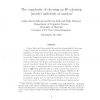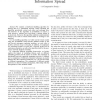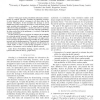580 search results - page 2 / 116 » Choosing a random peer |
STOC
2002
ACM
14 years 7 months ago
2002
ACM
Cooper, Dyer and Frieze studied the problem of sampling H-colourings (nearly) uniformly at random. Special cases of this problem include sampling colourings and independent sets a...
MCS
2010
Springer
13 years 9 months ago
2010
Springer
Abstract. Functional magnetic resonance imaging (fMRI) is a noninvasive and powerful method for analysis of the operational mechanisms of the brain. fMRI classification poses a sev...
QEST
2009
IEEE
14 years 2 months ago
2009
IEEE
—We consider a distributed shuffling algorithm for sharing data in a distributed network. Nodes executing the algorithm periodically contact each other and exchange data. The be...
FOCS
2006
IEEE
14 years 1 months ago
2006
IEEE
We consider the problems of Byzantine Agreement and Leader Election, where a constant fraction b < 1/3 of processors are controlled by a malicious adversary. The first problem...
ICC
2009
IEEE
14 years 2 months ago
2009
IEEE
Abstract—This paper studies probabilistic information dissemination in random networks. Consider the following scenario: A node intends to deliver a message to all other nodes in...



